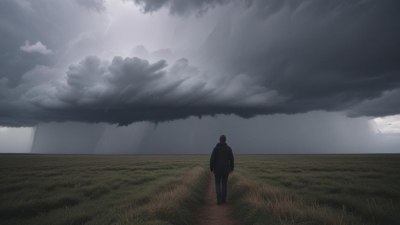What the Weather Can Teach Us About Showing Up for Each Other
Discover the lessons weather patterns offer on empathy, support, and community resilience during tough times.

Image created with Flux Schnell
Weather shapes our everyday experiences, influencing not just our physical environment but also our emotional and social lives. While often viewed simply as a backdrop to our routines, weather can also provide profound metaphors for understanding how we support each other through challenges. From the unpredictability of a storm to the steady warmth of sunshine, weather reminds us of the importance of showing up for one another in meaningful, consistent ways.
Every season carries unique teachings. Just as spring signifies renewal and growth after winter’s dormancy, times of hardship in life often precede personal transformation and stronger bonds. When the cold frost melts away, it encourages us to thaw rigidity in our relationships, inviting openness and vulnerability. This cyclical nature also suggests that no difficult phase lasts forever, a comforting reminder to be patient and present with others as they navigate their own storms.
Consider the way rain nourishes the earth despite its potential to disrupt daily plans. Rain requires us to adapt—finding shelter, adjusting schedules, or simply embracing the wetness. This adaptability mirrors how we can offer flexible support to those around us, recognizing that everyone’s needs fluctuate based on circumstances. Sometimes, a listening ear or a quiet presence is what a person needs; other times, active help like cooking a meal or running errands is necessary.
Storms, with their intensity and sudden force, often symbolize human struggles such as grief, anxiety, or crisis moments. Observing how communities come together after natural disasters offers valuable lessons about resilience and solidarity. People band together—sharing resources, providing comfort, rebuilding homes—demonstrating the power of collective effort. In our personal networks, showing up means responding to emotional storms with empathy instead of judgment, acknowledging pain without trying to immediately fix it, and making space for authentic expression.
Sunshine, often equated with positivity and warmth, also teaches us to celebrate the small joyful moments in our connections. Just as exposure to sunlight is vital for growth in plants and human health, the lightness of laughter, gratitude, and encouragement fuels relationships. A sunny attitude can lift the spirits of others, but genuine care involves more than surface brightness; it encompasses consistency and reliability, much like the dependable patterns of daylight cycles.
Wind reminds us of the unseen forces that influence feelings and moods, sometimes stirring restlessness or change. Like a breeze that carries seeds to new places, ideas and support can help others grow beyond their present situations. Listening carefully to these subtle shifts in behavior enables us to respond with sensitivity, offering guidance or space as needed. Wind also teaches about letting go—accepting that control over others’ experiences is limited and that sometimes, support means simply allowing growth along its natural course.
Fog, with its obscured visibility, parallels times when uncertainty clouds our thinking or emotions. During such periods, people often feel isolated or hesitant to reach out. Understanding this, showing up might involve gentle encouragement to move forward, reassurance that confusion is normal, and patience until clarity returns. Much like driving cautiously through foggy conditions, supportive relationships require care, attentiveness, and mutual trust to safely navigate ambiguity.
Seasons of drought remind us of scarcity—not just of water, but emotional resources as well. During these times, individuals may withdraw, conserve their energy, or struggle with depletion. Recognizing these signals is crucial for friends and family to offer timely care without overwhelming. It’s a call to nurture resilience by maintaining connection even when interactions are minimal, demonstrating steady presence so that renewal is possible when the time comes.
On the cultural front, weather has long influenced rituals and collective behaviors that strengthen social bonds. Festivals marking harvests, rains, or solstices reinforce shared identity and mutual support within communities. These traditions foster a rhythm of togetherness that helps individuals feel grounded and cared for. Applying this insight today, creating intentional moments for connection—whether through gatherings, outreach, or simple check-ins—builds social safety nets crucial for well-being.
In practical terms, just as meteorologists monitor weather patterns to anticipate events, we benefit from being attentive to the emotional climates of those around us. Awareness about stress signals, mood shifts, and life changes allows us to offer appropriate support proactively. Deepening our emotional intelligence enhances our capacity to show up effectively, transforming isolated struggles into shared experiences bolstered by care.
Moreover, weather teaches humility. We cannot control the elements, only how we prepare and respond. Similarly, despite best intentions, we cannot solve every problem or shield others from pain. Accepting this limitation encourages compassionate presence over pressured fixes, validating feelings rather than dismissing them. It promotes patience and endurance, qualities essential for sustainable relationships.
Weather also encourages us to embrace interdependence. Just as ecosystems rely on complex interactions between sun, rain, soil, and air, communities thrive when members support each other’s growth and healing. Recognizing our mutual dependencies fosters gratitude and responsibility, inspiring actions that uplift collective well-being beyond individual concerns.
On a symbolic level, weather phenomena reflect internal states. Calm clear skies may correspond to peace and clarity, while turbulent storms mirror inner conflict. This mirroring invites mindfulness practices that attune us to emotional rhythms, cultivating empathy not only for ourselves but also for others. Such awareness strengthens our ability to respond compassionately when someone is struggling, acknowledging the shared humanity underlying diverse experiences.
Technology now allows unprecedented access to real-time weather data, enabling preparedness and connection. Similarly, digital tools can facilitate support networks that reach beyond geographic boundaries. Online communities, mental health apps, and virtual gatherings create new avenues for showing up, particularly important in times of social distancing or mobility constraints. However, maintaining genuine empathy in such spaces requires intentional effort to preserve authenticity and emotional depth.
Environmental challenges underscore our collective vulnerability and interconnection. Climate change impacts weather patterns globally, often disproportionately affecting marginalized groups. This reality highlights the necessity of solidarity not only on a personal level but also societally, advocating for justice and shared responsibility. Showing up in this broader context means supporting policies and practices that safeguard communities and ecosystems alike, recognizing that well-being is interconnected across scales.
Returning to our personal relationships, the metaphor of weather encourages balanced responses: neither overwhelming with constant intervention nor withdrawing entirely. Similar to how nature cycles through extremes and balance, effective support involves attuning to cues, offering help when needed, and stepping back respectfully. This dance fosters autonomy while preserving connection, essential for healthy, enduring bonds.
Ultimately, weather reminds us that life is marked by change and uncertainty, but also by renewal and growth. Embracing this dynamic encourages resilience both individually and collectively. Showing up for each other through all seasons—sunny or stormy—creates a network of care that sustains us through life’s fluctuations.
By observing the rhythms of nature, respecting its power and fragility, we learn valuable lessons on empathy, timing, and presence. These lessons translate into actions—listening deeply, offering help thoughtfully, celebrating joy authentically, and standing together in adversity. Through such practices, we honor our shared humanity and the promise inherent in every day, regardless of the weather outside.
Our commitment to showing up for each other shapes the quality of our lives, much like weather shapes the environment. Just as plants and animals depend on consistent climatic patterns to thrive, human relationships require reliability and care to flourish. Weather teaches us that support is not one-time but continuous—nurturing growth like gentle rain rather than fleeting sunbursts.
Incorporating these lessons can transform how communities approach mental health, crisis response, and everyday kindness. They encourage proactive efforts to build networks of support that are resilient to both predictable seasons and unexpected storms. When people feel seen and supported, they are more capable of extending compassion further, creating a positive ripple effect that uplifts societies as a whole.
Thus, the weather is more than a physical phenomenon; it is an enduring metaphor and teacher. Its lessons on presence, empathy, adaptability, and interconnectedness offer guidance for fostering relationships grounded in genuine care. By embodying these principles, we contribute to a world where nobody faces hardships alone—where each person can count on meaningful support, rain or shine.











